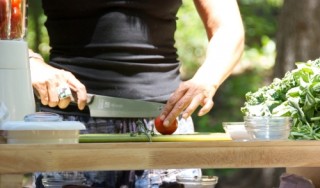However, not everyone was raised in the kitchen. You may have never acquired the skills it takes to prepare a meal that is healthy as well as fun and simple to make!
First things first: put away all fear about cooking being complicated and stressful. Making your own food can be incredibly empowering and relaxing when approached with a sense of openness and creativity. Your meal does not have to be perfect. It does, however, need to include healthy ingredients, prepared properly using the right tools (yes, your kitchen runs on tools!).
Follow these beginner cooking tips to get you slicing, dicing, sauteeing, baking, and broiling your way to a slimmer you!
Invest in essential tools
Preparing food correctly requires some basic items. The following is a shortlist of tools that you may need to prepare a meal that satisfies:
Pots and Pans:
-
Large skillets (1 regular or cast-iron, 1 nonstick)
-
Small skillet (so you can fry up quick breakfasts like these!)
-
Medium saucepan
-
2 Rimmed baking sheets
-
9-by-13-inch baking dish
Knives:
-
Chef’s knife
-
Paring knife
-
Serrated knife
Utensils:
-
Straight-edged wooden spoon
-
Tongs
-
Metal spatula
-
Silicone spatula
-
Whisk
-
Large metal spoon
-
Slotted spoon
-
Ladle
-
Y-shaped peeler
-
Basting brush (for recipes like these Deviled Pork Chops)
Other
-
Cutting boards
-
Mixing bowls
-
Dry measuring cups
-
Liquid measuring cups
-
Measuring spoons
-
Can opener
-
Box grater
-
Rasp grater
-
Colander
-
Salad spinner
-
Sieve
-
Instant-read
-
thermometer
-
Pepper grinder
Get Seasoning Skills
The natural flavor of food can become near-divine with the right seasonings.
When using salt and pepper, opt for kosher salt and freshly ground pepper for optimal flavor. Add salt with your fingers for the most artistic control.
To add complexity to a meal, use herbs. Long-lasting favorites like fresh basil or thyme boost the body of roasts and sautes. Fresh, chopped flat-leaf parsley serves as the perfect addition to finished meals.
To brighten meals, use acids like lemon juice, lime juice, and vinegar on your cooked meats and vegetables. Another excellent finish for vegetable dishes is a dash of olive oil, providing flavor enhancement while adding a subtle taste all its own.
Roasting Makes It Easy
Roasted meats and vegetables maintain moistness and flavor. Mix both in the same pan for a balanced meal that cooks simply and easily. Winter foods, including carrots and Brussels sprouts absorb the flavor of meats they are paired with well.
There are thousands of recipes that you can create just by following a few simple steps and using a few basic tools. Get excited and get cookin’!

